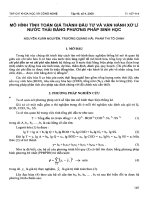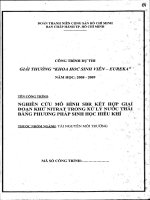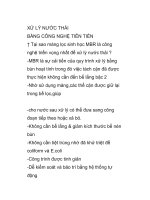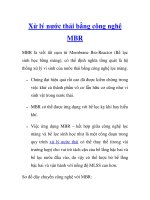Xử lý nước thải bằng công nghệ sinh học ppsx
Bạn đang xem bản rút gọn của tài liệu. Xem và tải ngay bản đầy đủ của tài liệu tại đây (257.04 KB, 9 trang )
Review of MBR - Hydro One 1
www.hydro1.com.my
B R
M
embrane io- actor
e
Wastewater and Effluent Treatment:
A Review of Membrane Bio-Reactor Technology
PLUS-POINTS of MBR >
Biodegradation efficiency enhanced 10%~30%
Short Hydraulic Residence Time (HRT)
Long Sludge Residence Time (SRT)
Activated sludge increase by 2~3 times
No secondary settling and disinfecting tank required
Automatic control operation is possible
Better control of biological activity
Quality Effluent that is free of bacteria and pathogens
Smaller plant size
Higher organic loading rates
Review of MBR - Hydro One 2
www.hydro1.com.my
MEMBRANE BIOREACTOR (MBR)
FOR
ADVANCED WASTEWATER TREATMENT &
Why MEMBRANE Technology?
M
e
p
b
C
M
p
t
mbrane technology has advanced significantly in the past decade, for both water
urification and wastewater treatment. Today, membrane-based systems have
ecome the preferred technology for many potable water purification applications:
ryptosporidium and Giardia control, color or suspended solids removal, etc.
ost recently, the combination of membranes with the activated sludge
rocess has redefined basic sewage treatment, optimizing the biological
reatment operation and yielding a treated effluent that is ideal for reuse.
▪ Two key advances in membrane technology are at the leading edge of this trend:
a.)Quality & bacteria-free effluent with high efficiency in removing organic & inorganic matters
b.)Minimum plant size with elimination of conventional element
c.) Stable & efficient biological process is maintained
▪ Membranes are low-pressure driven element and available in a diverse range of forms and
configurations, with membrane pore size or molecular weight (MW) separation being the
primary characteristic of differentiation.
What is MBR?
MBR (Membrane Brio-Reactor) can be broadly defined as systems integrating biological
degradation of waste products with membrane filtration.
▪ They have proven effective in removing both organic and inorganic contaminants as well as
biological entities from wastewater.
▪ MBR systems may be used with aerobic or anaerobic suspended growth bioreactors to
separate treated wastewater from the biomass.
▪ Set up of MBR is mainly utilizing a bioreactor and membrane filtration as one unit process
for wastewater treatment thereby replacing, and in some cases supplementing, the solids
separation function of secondary clarification and effluent filtration, resulting the possibility to
eliminate the secondary clarification and operate at higher MLSS concentration.
Review of MBR - Hydro One 3
www.hydro1.com.my
Fig. 1 – Flowchart of Membrane Bio-Reactor.
Fig. 2 – Immersed Type & External Type Membrane Module for MBR
Membrane used in MBR application can be type of immersed membrane module or external membrane
module. Immersed type membrane modules are immersed within the MBR tank and operate on suction
basis, where effluent is sucked out from module outlet. External membrane modules operate on
pressure basis, where untreated effluent is pressurized into inlet of external module from the MBR tank.
(Refer Fig. 2)
Advantages of the MBR:
▪ Better control of biological activity
▪ Effluent that is free of bacteria and pathogens
▪ Smaller plant size
▪ Biodegradation efficiency enhanced 10%~30%
▪ Short Hydraulic Residence Time (HRT) & Long Sludge Residence Time (SRT)
▪ Activated sludge increase by 2~3 times
▪ No secondary settling and disinfecting tank required
▪ Higher organic loading rates
*(more advantages will be discussed in detail in the next sessions)
Review of MBR - Hydro One 4
www.hydro1.com.my
Not only have there been numerous successful pilot scale studies, some full scale units are in
use in various parts of the world. Current applications include:
▪ industrial wastewater treatment
▪ municipal wastewater treatment and reuse
▪ water recycling in buildings
▪ landfill leach ate treatment
How can MBR turn out to be your solution?
▪ The performance and efficiency of conventional biological reactor systems is limited by
clarifier performance. (Refer Fig. 2)
▪ This is a function of operator skill, sludge settle-ability, basic clarifier design, solids
management, and the extent and rate of variability in hydraulic or organic loading.
▪ When upsets occur, solids can be lost and plant performance compromised. In order to
maintain adequate settling characteristics, suspended growth activated sludge plants are
limited to mixed liquor suspended solids (MLSS) concentrations of less than 3,500 mg/L.
Fig. 2 – Flowchart of Conventional Treatment System Vs. Membrane Bio-Reactor.
Review of MBR - Hydro One 5
www.hydro1.com.my
▪ With membrane separation, however, the normal clarification process is eliminated and
replaced by a simple, reliable and positive barrier to all suspended solids and
microorganisms. (Refer Fig. 2)
▪ Separation performance is independent of the quality, or condition of the biological process
fluid and the entire treatment process is simplified. Process upset problems, associated with
sludge bulking and difficult mixed liquor floc conditions, are eliminated. As a result, a very
stable and efficient biological process is maintained.
Operating at MLSS levels of up to 16,000 mg/L, membrane bioreactors create a significantly
more efficient process environment that enhances organic consumption and reduces sludge
production.
▪ Most MBRs operate effectively at short Hydraulic Retention Times (HRT), and are designed
to provide long Solids Retention Times (SRT).
▪ HRT periods of less than 6 hours and SRT duration in excess of 6 months are common.
▪ With such a low HRT, reactor volumes may be significantly reduced. Also, combining long
SRT with high biomass results in a more efficient process for destroying more complex
organics, reducing sludge yield and producing a highly stabilized sludge.
▪ In many applications, the extremely compact size of the MBR allows the entire system to be
enclosed in a compact “closed” system. Frequently, the entire system is located inside the
commercial or institutional building or facility, close to the source of the wastewater, thereby
reducing installation costs.
The extremely high quality of the permeate from the Immersed Hollow-fiber Membrane, MBR
makes wastewater reuse an achievable and a cost-effective option.
Combining the membrane technology with carbon filtration and ultra-violet disinfection, the
treated stream is suitable for re-use as toilet flush-water, for architectural or landscape water
features, for irrigation or for almost any other non-potable application.
While still relatively new and unfamiliar to many engineers and owners, the MBR (membrane
bioreactor) technology for wastewater treatment is a well-proven, reliable and cost-effective solution.
▪ easy to operate & maintain, with a high resistance to process upset
▪ a tertiary quality effluent that is suitable for reuse: toilet flush, irrigation, water
gardens, etc.
▪ odor-free
▪ microorganism-free effluent
▪ low sludge yield
▪ negligible chemical requirements
▪ ease of integration into existing plants for upgrade applications
▪ modular membrane structure for future capacity increases.
Review of MBR - Hydro One 6
www.hydro1.com.my
How does it work?
▪ Connected through the header system to the suction side of a permeate pump, the
membranes are subjected to a slight negative pressure of 20 to 50 kPa (3 to 7 psi).
▪ In an “outside-in” process operation, water is drawn from the mixed liquor through the
membrane wall and into the capillary, further enhanced by suction effect of pump. From
there, the treated water is drawn through the header and out through the discharge system.
▪ On a continuous basis, air is pumped into the bottom header, where it emerges as a coarse
bubble stream. This air stream performs the triple role of process aeration, mixing of the
biomass and membrane cleaning.
▪ This suction-based technology eliminates the need to pump mixed liquor through the
membrane system, significantly reducing the potential for membrane fouling and
dramatically lowering energy consumption.
▪ Also, with the continuous movement of air bubbles around and through the fibers, a lower
concentration of biomass is maintained around the membranes and this, in turn, minimizes
the potential for membrane fouling.
Fig. 2 – Schematic Diagram of MBR’s set up & components.
Review of MBR - Hydro One 7
www.hydro1.com.my
Hydro One Membrane for MBR Application
The recent development of less expensive and more efficient hollow fiber membrane from
Hydro One has generated new concept in membrane filtration application.
▪ It is capable of separating both insoluble solids in the process fluid (bacteria, viruses,
colloids and suspended solids) as well as higher molecular weight soluble organics, where
nominal pore sizes ranging from 0.1~0.01 micron.
▪ The Hollow Fiber Membranes are used to construct the Immersed Type MBR Membrane.
The membrane capillaries are long, flexible and extremely durable. These membranes are
“clamped” into top and bottom distribution tubes, and will be assembled into as a membrane
module.
▪ Membranes are immersed directly into the mixed liquor
of the biological reactor, reducing the entire treatment
process to a single-step operation and replacing the
clarifier of a conventional plant with an ultimate barrier
for biomass control.
▪ Almost all systems are now based on the significantly
more energy efficient, immersed, hollow-fiber
membrane, which exhibits a very large membrane
surface area.
▪ The large surface area in contact with the process fluid
allows operation at very low trans-membrane pressures.
This, in turn, reduces fouling of the membrane surface
and allows for extended periods of operation with very
low maintenance.
Characteristic of Hydro One Hollow Fiber Ultra-Filtration Membrane used in MBR application:
Specification - Model MBR-1000
▪ Material : Polypropylene
▪ Capillary Thickness : 40 ~ 50 µm
▪ Capillary Outer Diameter : 450 µm
▪ Capillary Pore Diameter : 0.01 ~ 0.2 µm
▪ Gas permeation : 7.0 x 10
-2
cm
3
/cm
2
• S • cmHg
▪ Porosity : 40 ~ 50%
▪ Lengthways strength : 120,000 kPa
▪ Designed flux : 6 ~ 9 L/M
2
/H
▪ Area of membrane module : 8 m
2
/module
▪ Operating Pressure : -10 ~ -30 kPa
▪ Flow-rate : 1.0 ~ 1.2 m
3
/ day
Review of MBR - Hydro One 8
www.hydro1.com.my
Typical Cases (for reference only)
Sewerage treatment/ recycle
Wastewater→ Grating → MBR → Effluent
Item COD
cr
(mg/l) BOD
5
(mg/l) SS (mg/l) NH-N
3
(mg/l)
Influent < 400 < 300 < 50 < 50
Effluent < 30 < 4 < 2 < 10
Parameter
▪ HRT 4 ~ 6 hr
▪ Gas/ Water Ratio 30:1 ~ 35:1
▪ DO of MBR Tank 3 ~ 4 mg/l
▪ MLSS of MBR Tank 4000 ~ 6000 mg/l
Wastewater treatment in food industry
Wastewater→ Adjustment & sedimentation tank → Anoxic Tank → MBR→ Effluent
Item COD
cr
(mg/l) BOD
5
(mg/l) SS (mg/l) NH-N
3
(mg/l)
Influent < 2000 < 1500 < 200 < 50
Effluent < 100 < 30 < 10 < 10
Parameter
▪ HRT 10 ~ 20 hr
▪ Gas/ Water Ratio 40:1 ~ 60:1
▪ DO of MBR Tank 4 ~ 5 mg/l
▪ MLSS of MBR Tank 6000 ~ 8000 mg/l
Wastewater treatment in breed aquatics industry
Wastewater→ Adjustment & sedimentation tank → Anoxic Tank → MBR→ Effluent
Item COD
cr
(mg/l) BOD
5
(mg/l) SS (mg/l) NH-N
3
(mg/l)
Influent < 2000 < 1300 < 200 < 160
Effluent < 120 < 60 < 10 < 50
Parameter
▪ HRT 10 ~ 20 hr
▪ Gas/ Water Ratio 40:1 ~ 60:1
▪ DO of MBR Tank 4 ~ 5 mg/l
▪ MLSS of MBR Tank 6000 ~ 8000 mg/l
Review of MBR - Hydro One 9
www.hydro1.com.my
Wastewater treatment in chemical industry
High concentration organic wastewater→ PH adjustment → Coagulation settle →
Anoxic Tank → MBR→ Effluent
Item COD
cr
(mg/l) BOD
5
(mg/l) SS (mg/l) Chroma (times)
Influent < 3500 < 1200 < 1300 < 10
Effluent < 90 < 20 < 10 < 1
Parameter
▪ HRT 24 ~ 48 hr
▪ Gas/ Water Ratio 60:1 ~ 120:1
▪ DO of MBR Tank 4 ~ 5 mg/l
▪ MLSS of MBR Tank 8000 ~ 12000 mg/l
MBR Membrane - Modular design easy for
maintenance & future upgrade









